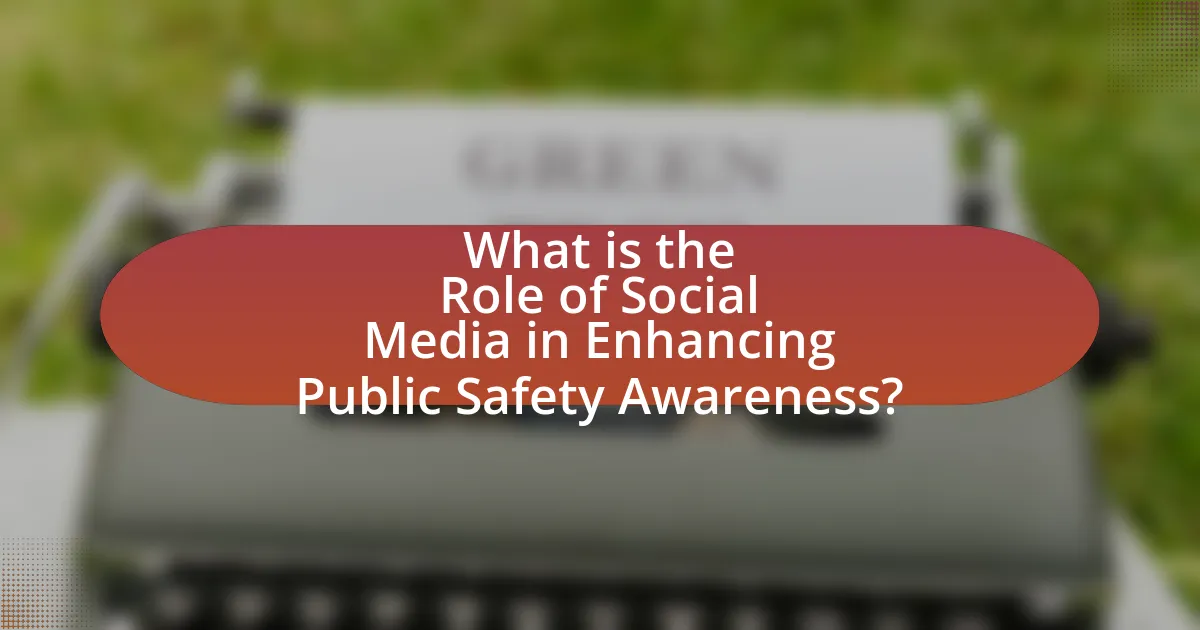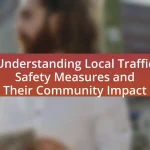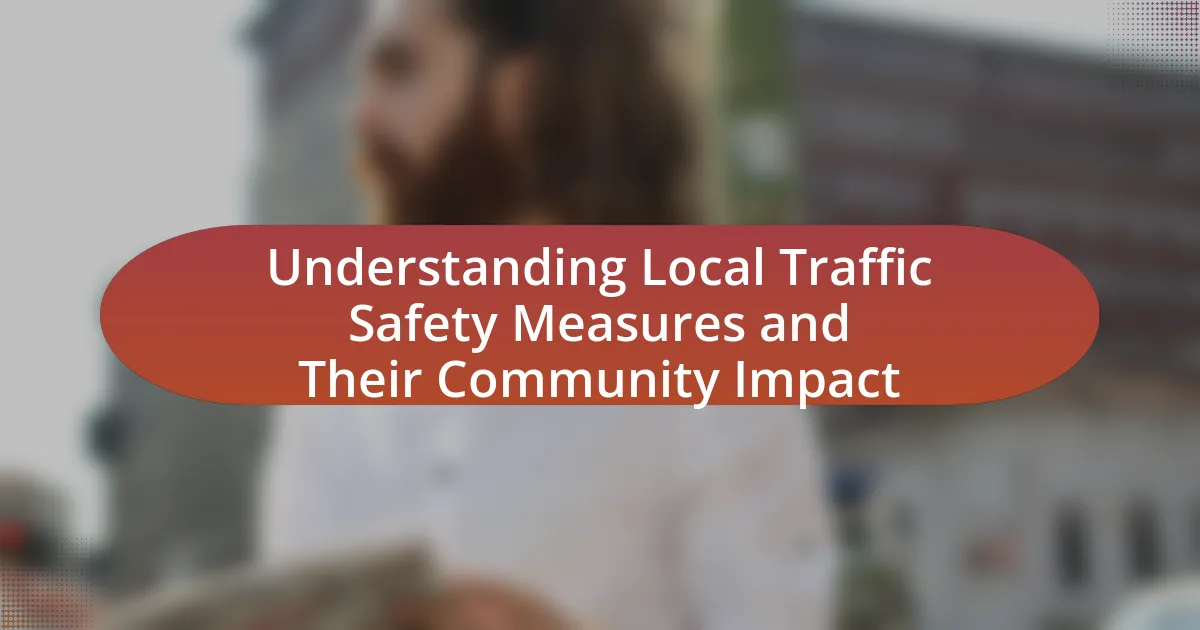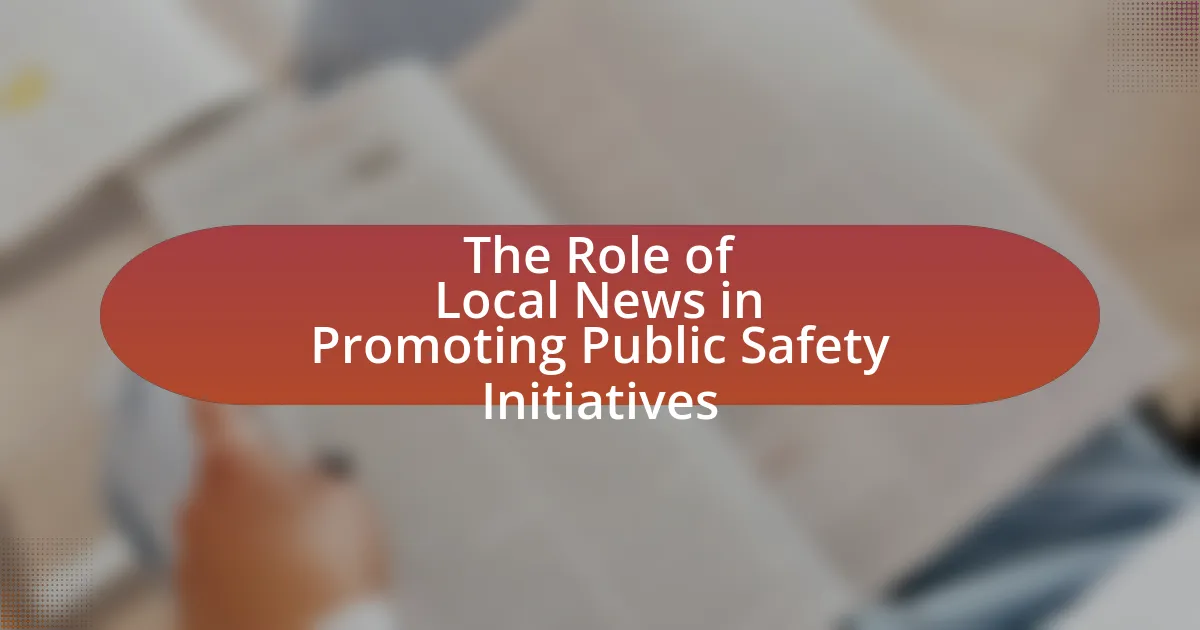The article examines the significant role of social media in enhancing public safety awareness. It highlights how platforms like Twitter and Facebook facilitate real-time communication and information dissemination during emergencies, improving public preparedness and response. The article discusses the effectiveness of various social media platforms in reaching diverse demographics, the importance of public safety awareness in crime prevention, and the consequences of low awareness levels. Additionally, it outlines strategies for organizations to effectively use social media for safety campaigns, the challenges they face, and future trends in leveraging technology for public safety communication.

What is the Role of Social Media in Enhancing Public Safety Awareness?
Social media plays a crucial role in enhancing public safety awareness by facilitating real-time communication and information dissemination. Platforms like Twitter and Facebook enable authorities to quickly share alerts about emergencies, natural disasters, and safety tips, reaching a wide audience instantly. For instance, during the 2017 Hurricane Harvey, the National Weather Service utilized social media to provide timely updates, which significantly improved public preparedness and response. Additionally, social media fosters community engagement, allowing users to share their experiences and safety concerns, which can inform local authorities and enhance overall safety strategies.
How does social media contribute to public safety awareness?
Social media contributes to public safety awareness by facilitating real-time communication and information dissemination during emergencies. Platforms like Twitter and Facebook enable authorities to share critical updates, such as weather alerts or safety instructions, quickly reaching a vast audience. For instance, during natural disasters, the Federal Emergency Management Agency (FEMA) utilizes social media to inform the public about evacuation routes and safety measures, significantly enhancing community preparedness. Studies indicate that 70% of people rely on social media for emergency information, underscoring its effectiveness in raising awareness and promoting safety.
What platforms are most effective for disseminating safety information?
Social media platforms such as Twitter, Facebook, and Instagram are most effective for disseminating safety information. These platforms enable rapid sharing and real-time updates, which are crucial during emergencies. For instance, a study by the Pew Research Center found that 69% of adults in the U.S. use Facebook, making it a powerful tool for reaching a broad audience quickly. Additionally, Twitter’s character limit encourages concise messaging, which is beneficial for urgent safety alerts. Furthermore, Instagram’s visual content can effectively convey safety messages, especially to younger demographics. These characteristics make social media an essential component in enhancing public safety awareness.
How do different demographics engage with safety content on social media?
Different demographics engage with safety content on social media in varied ways, influenced by factors such as age, gender, and cultural background. For instance, younger users, particularly those aged 18-24, tend to share safety content more frequently and engage with interactive formats like videos and polls, as evidenced by a Pew Research Center study indicating that 71% of this age group uses social media for news and information. In contrast, older demographics, such as those aged 50 and above, often prefer more traditional formats like articles and infographics, focusing on content that provides detailed information and actionable advice. Gender differences also play a role; women are more likely to engage with community safety initiatives and share personal safety tips, while men may focus on broader safety topics like emergency preparedness. Cultural factors further influence engagement, with diverse communities utilizing social media to address specific safety concerns relevant to their experiences, such as crime prevention or health emergencies.
Why is public safety awareness important in today’s society?
Public safety awareness is crucial in today’s society because it directly contributes to the prevention of crime and the protection of communities. Increased awareness enables individuals to recognize potential threats and respond appropriately, thereby reducing the likelihood of incidents. For instance, according to the National Crime Prevention Association, communities with active safety awareness programs experience a 20% decrease in crime rates. This statistic underscores the effectiveness of informed citizens in fostering safer environments. Additionally, public safety awareness promotes preparedness for emergencies, enhancing community resilience during crises such as natural disasters or public health emergencies.
What are the consequences of low public safety awareness?
Low public safety awareness leads to increased vulnerability to crime and emergencies. Individuals lacking awareness may not recognize potential threats, resulting in higher rates of victimization; for instance, communities with low safety awareness often experience a 20% higher crime rate, as reported by the National Crime Prevention Association. Additionally, inadequate awareness can hinder effective emergency response, as seen during natural disasters where unprepared populations face greater risks, leading to higher casualties and property damage. Overall, low public safety awareness significantly compromises community safety and resilience.
How can increased awareness lead to better community responses?
Increased awareness can lead to better community responses by fostering informed decision-making and encouraging proactive engagement among residents. When community members are aware of safety issues, they are more likely to participate in local initiatives, report suspicious activities, and collaborate with law enforcement. For instance, a study by the Pew Research Center found that 70% of social media users reported that these platforms helped them stay informed about local events and safety concerns, which directly correlates with increased community vigilance and responsiveness. This heightened awareness not only empowers individuals but also strengthens community ties, leading to a more cohesive and effective response to public safety challenges.
What are the key strategies for using social media to enhance public safety awareness?
Key strategies for using social media to enhance public safety awareness include timely information dissemination, community engagement, and targeted messaging. Timely information dissemination ensures that the public receives alerts about emergencies or safety issues as they occur, which can significantly reduce risks; for instance, the use of Twitter by emergency services during natural disasters has proven effective in reaching large audiences quickly. Community engagement fosters a sense of shared responsibility and encourages citizens to participate in safety initiatives, as seen in campaigns that invite user-generated content related to local safety concerns. Targeted messaging involves tailoring content to specific demographics or communities, which increases the relevance and impact of safety messages; research indicates that localized messaging can improve public response rates by up to 50%. These strategies collectively enhance public safety awareness by leveraging the unique capabilities of social media platforms to inform, engage, and mobilize communities effectively.
How can organizations effectively create engaging safety campaigns?
Organizations can effectively create engaging safety campaigns by utilizing targeted messaging, interactive content, and leveraging social media platforms. Targeted messaging ensures that the campaign resonates with specific demographics, increasing relevance and engagement. Interactive content, such as quizzes or polls, encourages participation and fosters a sense of community around safety topics. Social media platforms, with their vast reach and ability to share multimedia content, allow organizations to disseminate information quickly and engage users through comments and shares. According to a study by the Pew Research Center, 69% of adults in the U.S. use social media, highlighting its potential as a powerful tool for safety awareness campaigns.
What role do influencers play in promoting public safety messages?
Influencers play a crucial role in promoting public safety messages by leveraging their large followings to disseminate important information quickly and effectively. Their ability to engage audiences through relatable content increases the likelihood that safety messages will be noticed and acted upon. For instance, during public health crises, influencers have been shown to significantly enhance the reach of safety campaigns, as evidenced by a study published in the Journal of Health Communication, which found that messages shared by influencers led to a 30% increase in public compliance with health guidelines. This demonstrates that influencers not only amplify the visibility of public safety messages but also contribute to behavioral change among their followers.
How can social media be used during emergencies to enhance public safety awareness?
Social media can be used during emergencies to enhance public safety awareness by providing real-time information, facilitating communication, and enabling community engagement. During crises, platforms like Twitter and Facebook allow authorities to disseminate urgent updates, such as evacuation orders or safety instructions, quickly to a wide audience. For instance, during Hurricane Harvey in 2017, the Texas Division of Emergency Management utilized social media to share critical information, which helped inform and protect residents. Additionally, social media enables users to share their experiences and needs, creating a two-way communication channel that can assist emergency responders in assessing situations and allocating resources effectively. This dynamic interaction fosters a sense of community and encourages individuals to stay informed and prepared, ultimately enhancing overall public safety awareness.
What are the best practices for real-time communication during crises?
The best practices for real-time communication during crises include establishing clear communication channels, providing timely and accurate information, and engaging with the audience through interactive platforms. Clear communication channels, such as dedicated social media accounts or emergency apps, ensure that information reaches the public quickly. Timely and accurate information is crucial; for instance, during the COVID-19 pandemic, organizations like the World Health Organization provided regular updates to keep the public informed. Engaging with the audience allows for feedback and questions, which can enhance trust and clarity. These practices are supported by research indicating that effective communication can significantly improve public response and safety during emergencies.
How can social media help in coordinating community responses during emergencies?
Social media can significantly enhance the coordination of community responses during emergencies by facilitating real-time communication and information sharing. Platforms like Twitter and Facebook allow local authorities and organizations to disseminate critical updates, such as evacuation orders or safety instructions, quickly to a wide audience. For instance, during Hurricane Harvey in 2017, social media was instrumental in sharing rescue requests and available resources, leading to more efficient response efforts. Additionally, social media enables community members to connect and organize volunteer efforts, as seen in various disaster relief initiatives where individuals coordinated aid distribution through group messaging and posts. This immediate connectivity and information flow can lead to more effective and timely responses, ultimately saving lives and resources during emergencies.
What challenges do organizations face when using social media for public safety awareness?
Organizations face several challenges when using social media for public safety awareness, including misinformation, audience engagement, and resource allocation. Misinformation can spread rapidly on social media platforms, leading to confusion and panic among the public; for instance, during emergencies, false information can undermine official messages and create public distrust. Engaging the audience effectively is another challenge, as organizations must compete with a vast amount of content and varying user interests, making it difficult to capture attention and convey critical safety messages. Additionally, resource allocation poses a significant challenge; organizations often struggle with limited budgets and personnel dedicated to managing social media efforts, which can hinder their ability to respond promptly and effectively to public safety issues. These challenges highlight the complexities organizations face in leveraging social media for enhancing public safety awareness.
How can misinformation on social media impact public safety efforts?
Misinformation on social media can significantly undermine public safety efforts by spreading false information that misleads the public during emergencies. For instance, during natural disasters, inaccurate reports about evacuation routes or safety measures can lead to chaos, hinder rescue operations, and increase the risk of harm to individuals. A study by the Pew Research Center found that 64% of Americans believe that misinformation on social media has caused confusion about important issues, including public health and safety. This confusion can result in delayed responses to crises, as individuals may not follow official guidance due to conflicting information circulating online.
What strategies can mitigate the risks associated with social media use in safety campaigns?
To mitigate the risks associated with social media use in safety campaigns, organizations should implement strategies such as establishing clear guidelines for content sharing, utilizing fact-checking mechanisms, and engaging with audiences through transparent communication. Clear guidelines help ensure that all shared content aligns with safety objectives and reduces the likelihood of misinformation. Fact-checking mechanisms can verify the accuracy of information before dissemination, which is crucial given that 59% of social media users encounter false information regularly. Engaging transparently with audiences fosters trust and encourages responsible sharing, ultimately enhancing the effectiveness of safety campaigns.
What are the future trends in social media and public safety awareness?
Future trends in social media and public safety awareness include the increased use of real-time data sharing, enhanced community engagement through interactive platforms, and the integration of artificial intelligence for threat detection. Real-time data sharing allows authorities to disseminate critical information quickly during emergencies, as seen in the use of Twitter alerts during natural disasters. Enhanced community engagement is facilitated by platforms like Facebook and Instagram, where local agencies can interact directly with citizens, fostering trust and collaboration. Additionally, artificial intelligence is being utilized to analyze social media content for potential threats, improving response times and resource allocation, as evidenced by studies showing AI’s effectiveness in monitoring public sentiment and identifying risks.
How might emerging technologies influence public safety communication?
Emerging technologies significantly enhance public safety communication by enabling real-time information sharing and improving response coordination. For instance, platforms like Twitter and Facebook allow emergency services to disseminate alerts and updates rapidly, reaching a wide audience instantly. According to a study by the Pew Research Center, 70% of Americans use social media, making it a vital tool for public safety announcements during crises. Additionally, technologies such as mobile apps and geolocation services facilitate targeted alerts to individuals in affected areas, further improving the effectiveness of communication strategies in emergencies.
What role will data analytics play in shaping safety awareness strategies?
Data analytics will play a crucial role in shaping safety awareness strategies by enabling organizations to identify trends, assess risks, and tailor communication efforts effectively. By analyzing data from social media platforms, organizations can monitor public sentiment, track the spread of misinformation, and understand community concerns in real-time. For instance, a study by the Pew Research Center found that 69% of adults in the U.S. use social media, making it a vital source of information for gauging public awareness and response to safety issues. This data-driven approach allows for the development of targeted campaigns that address specific safety concerns, ultimately enhancing public safety awareness and engagement.
What practical tips can organizations implement to enhance public safety awareness through social media?
Organizations can enhance public safety awareness through social media by implementing targeted communication strategies, engaging content, and community collaboration. Targeted communication strategies involve identifying specific safety issues relevant to the community and creating tailored messages that address these concerns. Engaging content, such as infographics, videos, and live Q&A sessions, can capture attention and facilitate understanding of safety protocols. Community collaboration can be fostered by partnering with local influencers and organizations to amplify safety messages, thereby increasing reach and credibility. For instance, the National Highway Traffic Safety Administration effectively uses social media campaigns to promote safe driving practices, demonstrating the impact of strategic messaging on public awareness.




